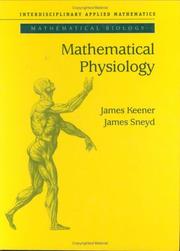| Listing 1 - 2 of 2 |
Sort by
|
Dissertation
Year: 1998 Publisher: [S.l.]: [chez l'auteur],
Abstract | Keywords | Export | Availability | Bookmark
 Loading...
Loading...Choose an application
- Reference Manager
- EndNote
- RefWorks (Direct export to RefWorks)
Biomathématiques --- Équations différentielles. --- Differential equations. --- Biomathematics --- Statistique médicale --- Biomathematique --- Modelisation mathematique --- Biomathematique --- Modelisation mathematique

ISBN: 0387983813 9780387983813 9780387227061 9786610010240 128001024X 0387227067 Year: 1998 Publisher: New York : Springer,
Abstract | Keywords | Export | Availability | Bookmark
 Loading...
Loading...Choose an application
- Reference Manager
- EndNote
- RefWorks (Direct export to RefWorks)
Mathematical Physiology provides an introduction into physiology using the tools and perspectives of mathematical modeling and analysis. It describes ways in which mathematical theory may be used to give insights into physiological questions and how physiological questions can in turn lead to new mathematical problems. The book is divided into two parts, the first dealing with the fundamental principles of cell physiology, and the second with the physiology of systems. In the first part, after an introduction to basic biochemistry and enzyme reactions, the authors discuss volume control, the membrane potential, ionic flow through channels, excitability, calcium dynamics, and electrical bursting. This first part concludes with spatial aspects such as a synaptic transmission, gap junctions, the linear cable equation, nonlinear wave propagation in neurons, and calcium waves. In the second part, the human body is studied piece by piece, beginning with an introduction to electrocardiology, followed by the physiology of the circulatory system, blood, muscle, hormones, and kidneys. Finally, the authors examine the digestive system and the visual system, ending with the inner ear. This book will be of interest to researchers, to graduate students and advanced undergraduate students in applied mathematics who wish to learn how to build and analyze mathematical models and to become familiar with new areas of application, as well as to physiologists interested in learning about theoretical approaches to their work. The inclusion of numerous exercises and models could be used to add further interest and challenge to traditional courses taught by applied mathematicians, bioengineers, and physiologists.
Histology. Cytology --- Human physiology --- Physiology --- Mathematics. --- Physiology -- Mathematics. --- Natural Science Disciplines --- Biological Science Disciplines --- Disciplines and Occupations --- Mathematics --- Human Anatomy & Physiology --- Health & Biological Sciences --- Human physiology. --- Biomathematics. --- Mathematical and Computational Biology. --- Human Physiology. --- Human biology --- Medical sciences --- Human body --- Biology --- Biologie moleculaire --- Biomathematique --- Physiologie
| Listing 1 - 2 of 2 |
Sort by
|

 Search
Search Feedback
Feedback About UniCat
About UniCat  Help
Help News
News